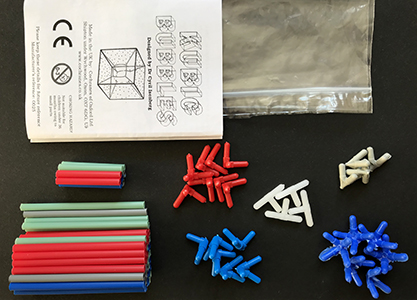
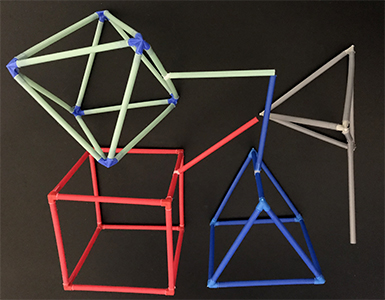
|
Micscape Lite - Product Review Cochranes of Oxford 'Kubic Bubbles' kit designed by Dr. Cyril Isenberg by David Walker, UK |
A recent project to create frozen soap bubbles on cold Peltier plates piqued a wider interest in soap bubbles. I was aware that complex bubbles can be formed within geometrical frames but have never explored them myself. This prompted me to buy the Cochranes 'Kubic Bubbles' kit and a short review is shared below.
The kit cost £6-95 (inc. VAT) direct from Cochrane's online shop and is simply presented in a zip-lock plastic bag. Four shapes can be made, a cube, prism, tetrahedron and octahedron. The straws and connectors for a given frame have the same colour. Assembly is straightforward but the straws are quite thin and a stiff fit so best to press them in holding them close to the connector to avoid bending. The very young may need aid. A spare straw for each frame is included. A right angle connector and straws of half length are supplied to create a handle along one edge of each frame as shown. The frames are 9 cm along each side. A fold-out leaflet is supplied with frame assembly instructions and advice for creating both basic and more complex bubbles within each frame. Also some notes on the basic physics and 'fundamental shapes' that are formed which reflect the films trying to minimise their surface area.
The typical sized paint kettle filled to the top holds about the right volume of water required to immerse fully. Half a cup of detergent into the bowl was suggested which is strong but a few second squirt of detergent into the kettle gave bubbles that lasted long enough to study. Some soap bubble recipes online are also concentrated and may include ingredients such as glycerine. It is noted to keep the water surface free of bubbles as these can interfere with perfect film shape formation (although some of these 'rogue' bubbles can be incorporated to form less symmetrical but interesting film formations!).


The kit before and after assembly. All shapes are dipped into and removed from the soap solution at a corner.

The 'fundamental surface' for the tetrahedron. The notes describe other forms that can be achieved for each shape. A central bubble can be formed by part reimmersing.
The notes also remark that no more than three film planes can form along an edge irregardless of the geometrical shape. A maximum of four edges or six films can meet at a point.
As soap film planes burst, curved complex shapes of the remaining intact films can form.
As the soap film drains and thins, attractive interference colours can be observed if the lighting is at the correct angle.
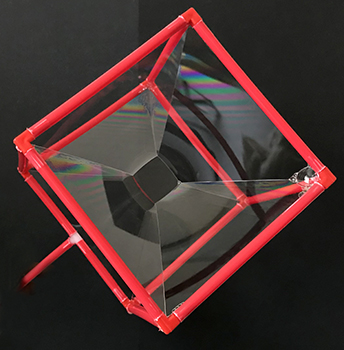
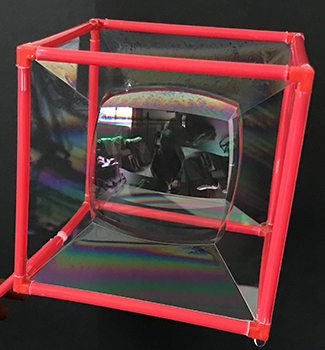
Left, the fundamental shape and, right, the internal bubble formed by part reimmersing.
If the cube is removed from the soap solution along a plane, the central structure is not formed but just planes on each cube face.

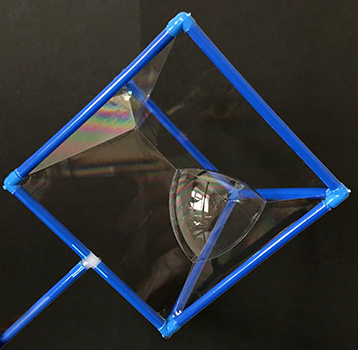
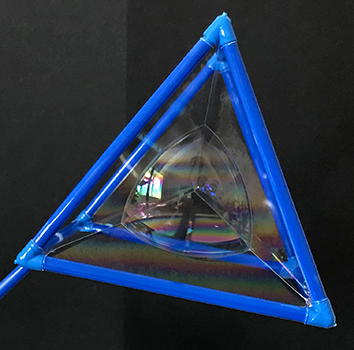
Left, the fundamental shape, middle, rogue bubble on surface when remove shape from solution can give asymmetrical forms, compared with that right.
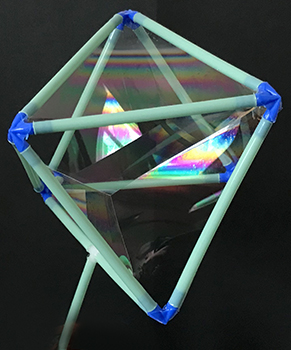
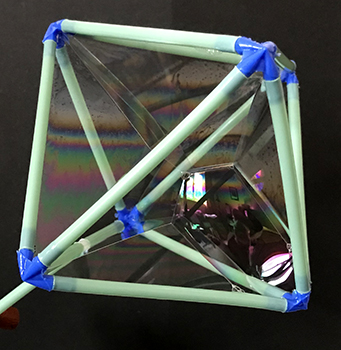
The fundamental shape for the octahedron is quite complex with rogue bubbles forming other shapes, right.
The notes suggest blowing a bubble into one plane to generate the true fundamental shape.
For less than £10 this kit provided a fascinating project on various levels. As well as their visual appeal, as the notes remark there is underlying maths associated with how soap films try adopt a minimal surface area within a given geometry. Photography is also a challenge and did not succeed above trying to keep the photographer out of some multiple reflections! The dilute soap solution used did not last long for photography; stronger solutions perhaps with added glycerine as recommended in some online recipes may be better.
For folk on a budget or who like homebrew, these shapes and more could be made with craft items that may be to hand. Small balls of Plasticine or BluTak using cocktail sticks or the rods of cotton buds may well work or wire frames made of stiff material. A piece of thread could serve as the dipping handle. Smaller models may be more convenient for some as a quite large soap container is required for this kit. Although could reduce the size of these models by half if desired by cutting all rods in half.
Comments to the author David Walker are welcomed.
Published in the March 2021 edition of Micscape.
Please report any Web problems or offer general comments to the Micscape Editor .
Micscape is the on-line monthly magazine of the Microscopy UK web site at Microscopy-UK
© Onview.net
Ltd, Microscopy-UK, and all contributors 1995 onwards. All rights
reserved.
Main site is at www.microscopy-uk.org.uk
with full mirror at
www.microscopy-uk.net
.